Churchyard History
The churchyard at an Old S.Pancras is an ancient site that is home to an historic church, the building of railways, the iconic telephone box, Charles Dickens, the Beatles and more than one powerful woman. It has a history that is constantly being written. As recently as 2012, it saw the Olympic torch passing through the Parish and the Gardens on its way to Stratford just hours before the opening ceremony.

We believe this has been a site of Christian worship since the 4th Century. Pancras was martyred in Rome 304, he was only 14 when he was beheaded by Diocletian. At the conversion to Christianity soon after, the story goes that St Pancras became a popular figure in the early Roman Church and with sectors of Roman society. He is often depicted in the uniform of a Roman soldier. The St Pancras Old Church you see today is largely the result of comprehensive restorations of the ancient building, in 1847, 1888 and 1925. Railing plaques outside, shows the Church beside the now hidden river Fleet in a rural setting, as it would have looked two centuries ago.
The Fleet continues to flow underground from the northern boundary of the former Parish where springs emanate from the Hampstead and Highgate ridge. It flows past St Paul’s Cathedral joining the Thames at Blackfriars. St Pancras Old Church has long links to St Paul’s Cathedral with references in the Domesday survey. You can read more about the history of the church on this page.
The Churchyard ceased to be used as a graveyard in 1854 by which time it had accommodated centuries of burials. In the 300 years from 1600 perhaps 1.5% of all London’s estimated 6 million burials may have been accounted for at St Pancras. Records indicate that between 1689 and 1854, 88,000 burials took place, over 32,000 in the final 23 years.
The Hardy Tree
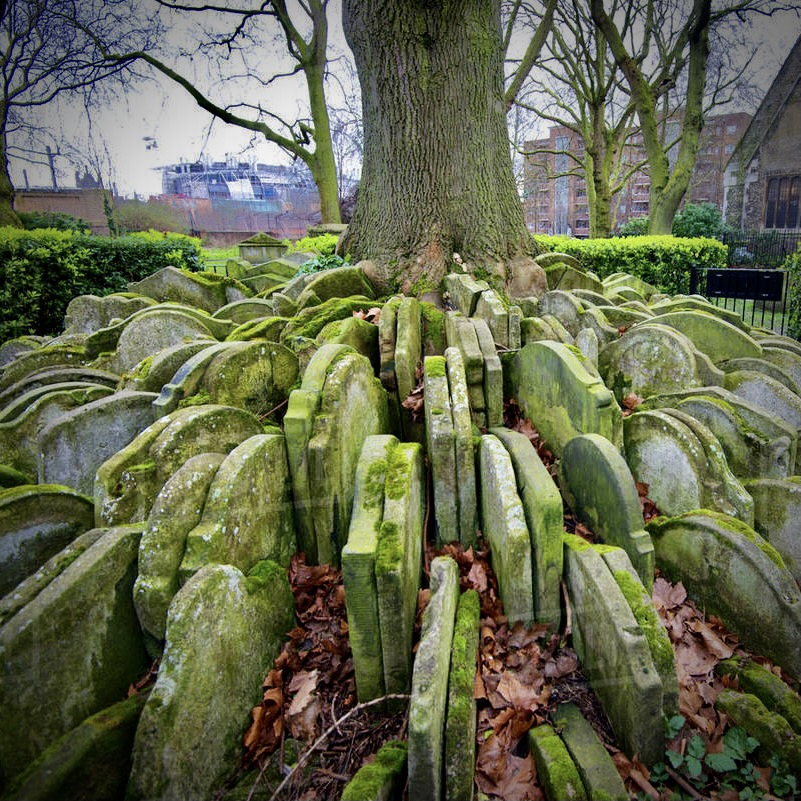
Here is a monument to the railway encroachments of the nineteenth century and one that is continuing to evolve. The writer Thomas Hardy was employed as an overseer for Arthur Blomfield the architect managing the disinterment of human remains. In his later writings a poem ends thus
There’s not a modest maiden elf Yet dreads the final trumpet Lest half of her should rise herself And half some sturdy strumpet
The wall to Gaul
Barely a decade old a new wall encloses the latest extended railway. The new St Pancras International opened 6th November 2007 serving up to 10 million Eurostar passengers each year travelling to and from mainland Europe. The high speed rail lines also mean that domestic passengers can get from St Pancras to Kent, with Stratford just seven minutes away on the Javelin Service.
Sir John Soane
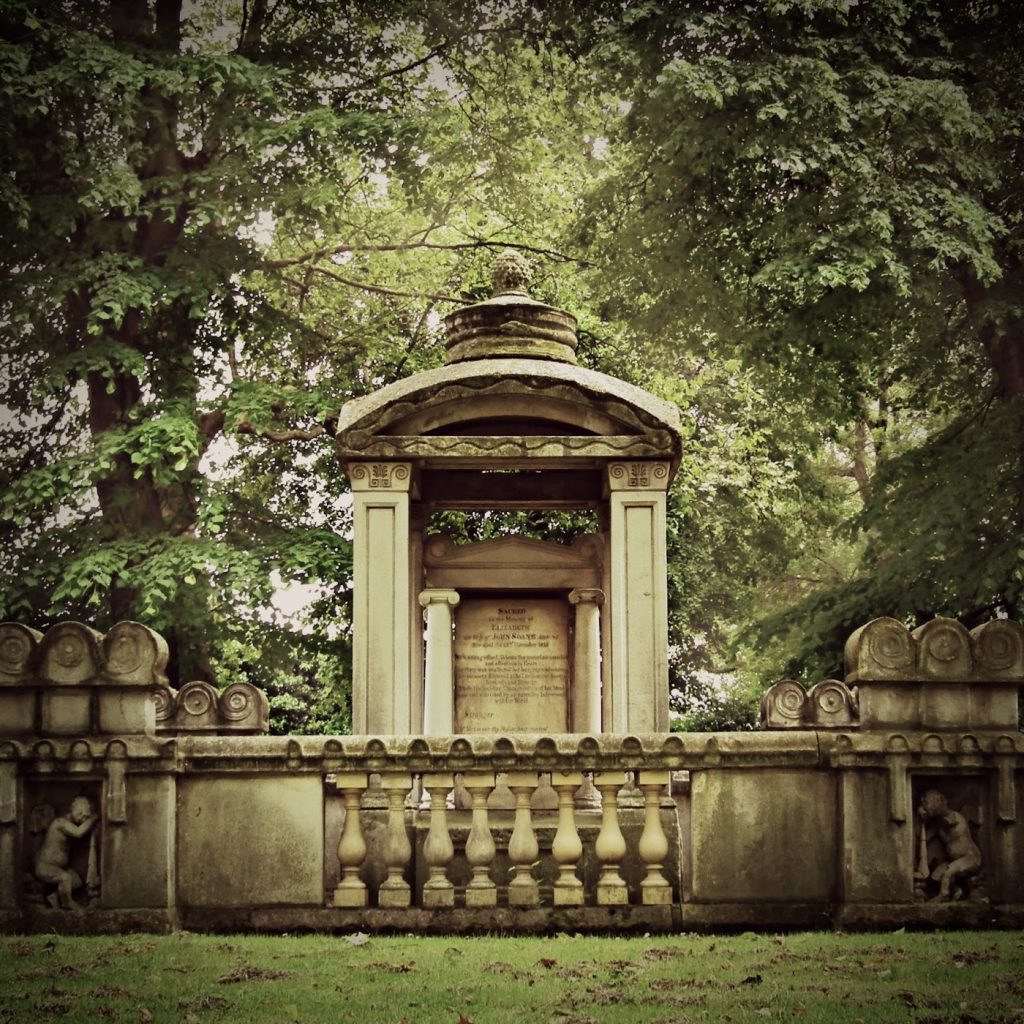
This monument records his death in 1837. It is one of only two Grade I listed monuments in London. Soane was the architect of the Bank of England and the Dulwich Picture Gallery. The death of his wife, and a son predeceasing him, meant he spent decades refining the design. A further son from whom he was bitterly estranged is absent. The monument looks for all the world like a telephone box, yet the telephone box was a century of being invented. In the 1920s the design competition was won by Sir Giles Gilbert Scott, grandson of George Gilbert Scott who built the St Pancras Hotel. As a trustee of the Sir John Soane Museum in Lincoln’s Inn Fields Soane’s design from a century earlier must have rung a bell. Very recently when a piece of stone from Soane’s monument went missing, telecommunications facilitated its rightful recovery. It was discovered and tracked down on eBay.
Mary Wollestonecraft
Born 27th April 1759 she was the author of ‘A Vindication of the Rights of Woman’, published 1792. She died 10th September 1797 just ten days after giving birth to a daughter (Mary Shelley 30th August 1797-1st February 1851), who went on to write ‘Frankenstein’. The stone memorial to William and Mary (Wollstonecraft) Godwin was previously further to the East. Their remains are no longer buried here. With the disruption of the railway the family removed them to Bournemouth.
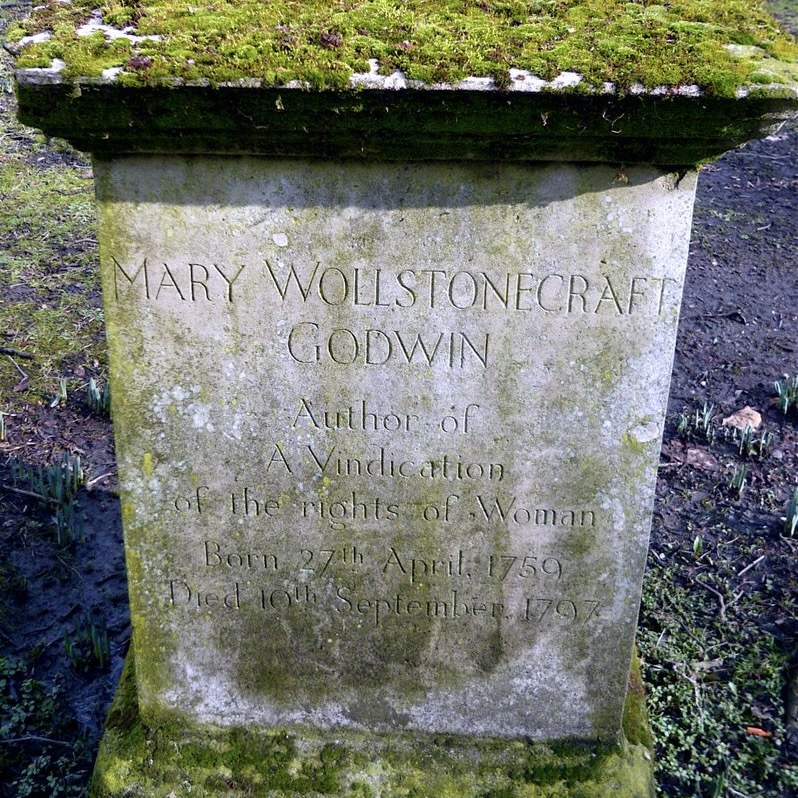
Charles Dickens
Charles Dickens born just over two hundred years ago (7th February 1812) spent part of his childhood with family friends nearby in Little College Street which is now known as College Place. His parents were at that time in prison for debt. The house has long gone but he described this area as a desolate place surrounded by little else than fields and ditches. He walked a great deal around London gaining inspiration, writing about housing and the canal near here. In ‘A Tale of Two Cities’ (1859) St Pancras Churchyard is where Jerry Cruncher and his son came fishing, (body snatching), in this case fishing with a spade. Roger Cly, an Old Bailey spy and character in the same book, was described as being buried here. Bayham Street is another place in the Parish where Dickens lived as a boy. The Micawber’s (David Copperfield) and Cratchits (A Christmas Carol) lived in Camden Town.
Gravestone of Mr Jones
Here the grave of Mr William Jones graphically illustrates the links to Dickens. Jones who died 20th January 1836, provided the inspiration for the ferocious headmaster. perhaps that ever lived … “
CHARLES DICKENS SCHOOLMASTER
AT WELLINGTON HOUSE ACADEMY
HAMPSTEAD ROAD
THE ORIGINAL "CREAKLE'S SCHOOL"
IN DAVID COPPERFIELD
AND "OUR SCHOOL" IN "REPRINTED PIECES".
The monument records “The inflexible integrity of his character and the social and domestic virtues which adorned his private life will long be cherished in the recollection of all those who knew him”. However, Dickens remembered him differently ” …by far the most ignorant man I have ever had the pleasure to know … one of the worse-tempered men
Baroness Burdett Coutts
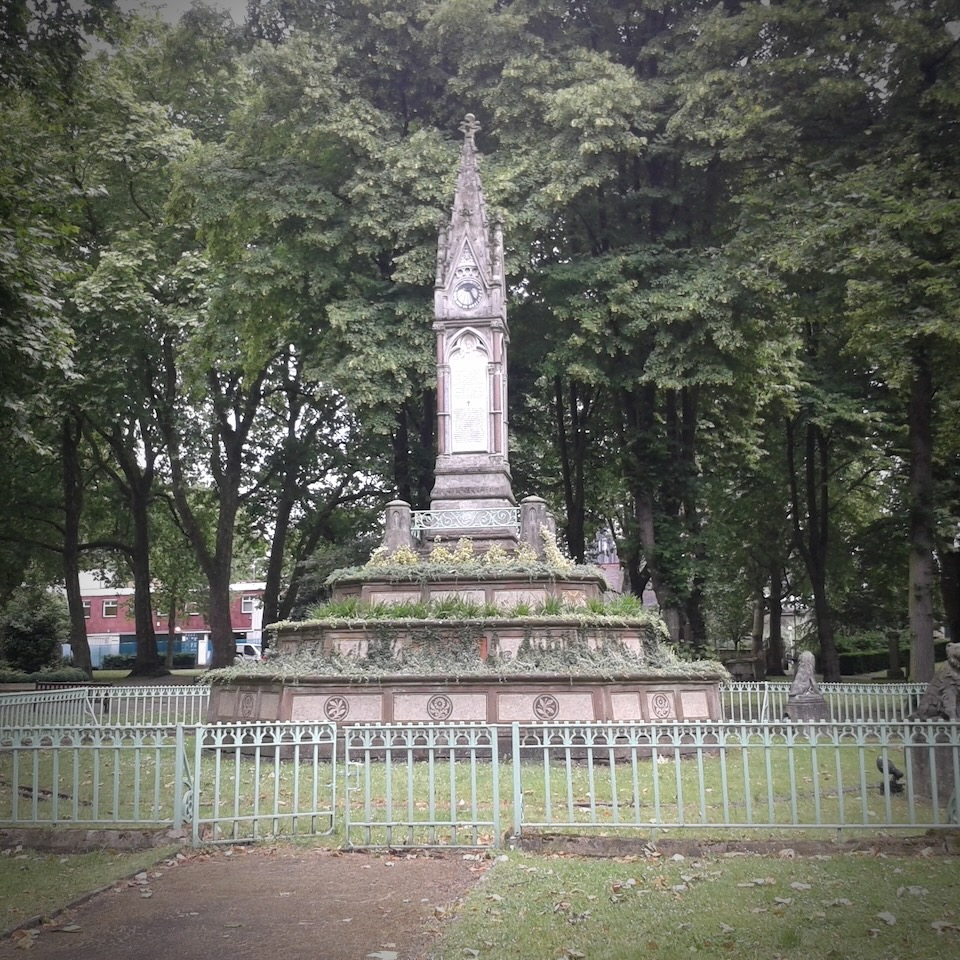
The name Coutts is familiar as the Queen’s bankers and she lived in Highgate to the North of the former Parish of St Pancras. A model estate designed for her workers ‘Holly Village’ survives next to Highgate Cemetery. A close friend and campaigner for a time with Dickens she was responsible for the ornate gothic sundial unveiled in 1879. It records on each side many notable figures and their professions including French emigres from the time of the Revolution. Burdett Coutts herself is buried in Westminster Abbey.
Bach to Beatles
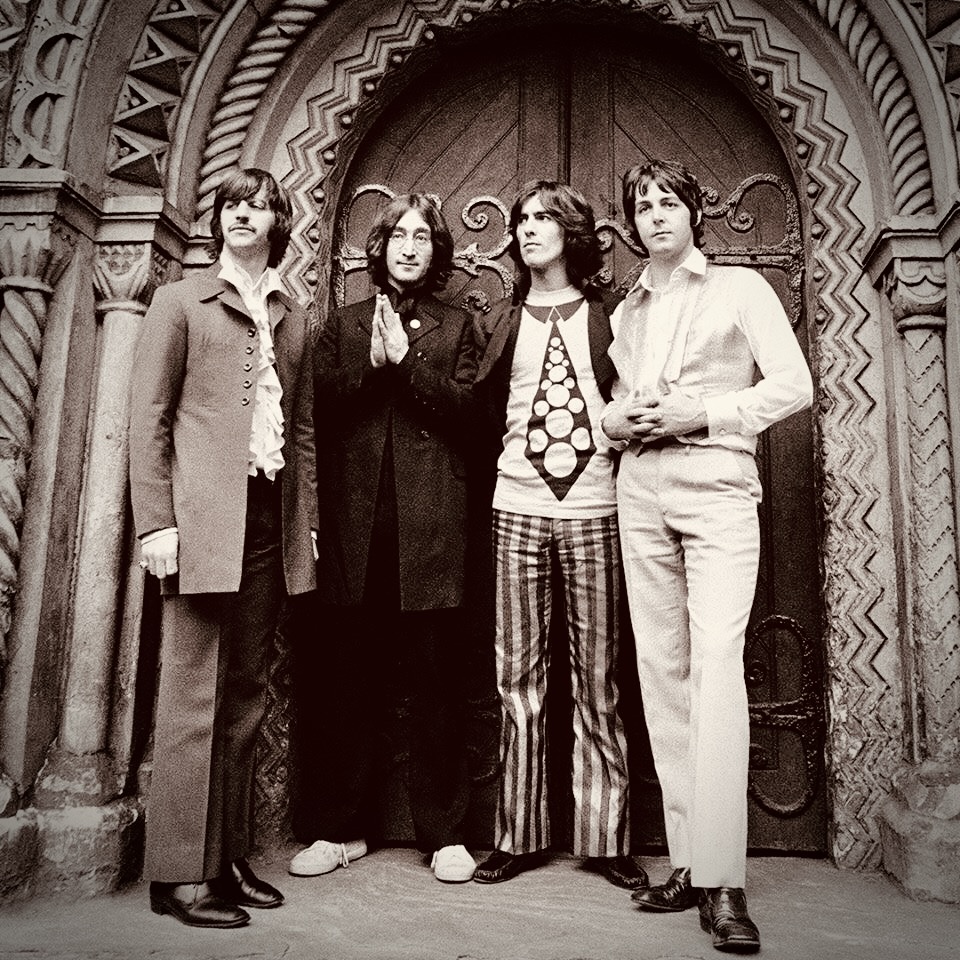
Tucked away along the northern side of the Burdett Coutts memorial is a plaque to ‘The English Bach’. Johann Christian Bach was music master to Queen Charlotte, wife of George Ill. Born in Leipzig 1735 he was the youngest son of Johann Sebastian Bach. He died on Tuesday 1st January 1782. With Carl Friedrich Abel (1723 – 1787), also buried in the churchyard, foreign musicians were introduced into London in Bach-Abel Concerts. The Beatles exploded on the popular music scene in the early 1960s. As the decade wore on getting them together in one place became increasingly difficult and the publicity photographs of the group were outdated. On Sunday 28th July 1968 a hop step and a jump from Bach’s two century old resting place, John, Paul, George and Ringo paused on a whirlwind photo shoot. To this day visitors arrive following the path of the Beatles ‘Mad day out in London’.
The Gardens in today’s community
The Gardens are managed by the London Borough of Camden. A circular stone marks their restoration in 2001 and the ornate gates have been repaired. Nearby new communities are arriving with student accommodation and other housing. There is a new University on the doorstep with St Martin Central School of Art and Design in the Granary, just across the Regent’s Canal. Down the road the Crick Institute, new offices and a transformed King’s Cross Station help to make this, we believe, the most well-connected Parish in the Church of England.
